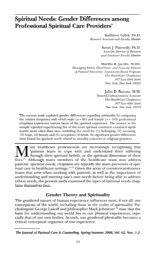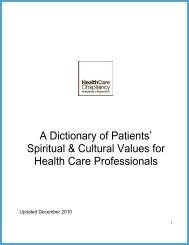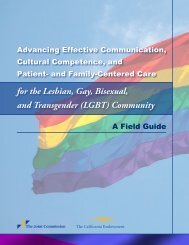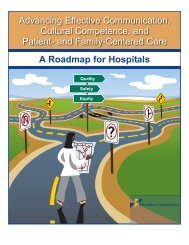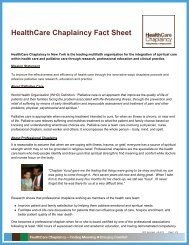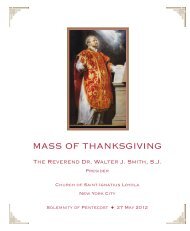What to Say and How to Pray with Jewish Patients in Chaplaincy
What to Say and How to Pray with Jewish Patients in Chaplaincy
What to Say and How to Pray with Jewish Patients in Chaplaincy
Create successful ePaper yourself
Turn your PDF publications into a flip-book with our unique Google optimized e-Paper software.
This article was downloaded by: [Sil<strong>to</strong>n, Nava R.]<br />
On: 4 August 2010<br />
Access details: Access Details: [subscription number 924724705]<br />
Publisher Routledge<br />
Informa Ltd Registered <strong>in</strong> Engl<strong>and</strong> <strong>and</strong> Wales Registered Number: 1072954 Registered office: Mortimer House, 37-<br />
41 Mortimer Street, London W1T 3JH, UK<br />
Journal of Health Care Chapla<strong>in</strong>cy<br />
Publication details, <strong>in</strong>clud<strong>in</strong>g <strong>in</strong>structions for authors <strong>and</strong> subscription <strong>in</strong>formation:<br />
http://www.<strong>in</strong>formaworld.com/smpp/title~content=t792322384<br />
Shema, Vidui, Yivarechecha: <strong>What</strong> <strong>to</strong> <strong>Say</strong> <strong>and</strong> <strong>How</strong> <strong>to</strong> <strong>Pray</strong> <strong>with</strong> <strong>Jewish</strong><br />
<strong>Patients</strong> <strong>in</strong> Chapla<strong>in</strong>cy<br />
Nava R. Sil<strong>to</strong>n a ; Cecille A. Asekoff b ; Rabbi Bonita Taylor c ; Rabbi Paul B. Sil<strong>to</strong>n d<br />
a<br />
The Spears Research Institute, Healthcare Chapla<strong>in</strong>cy, New York, New York, USA b Executive<br />
Direc<strong>to</strong>r, National Association for <strong>Jewish</strong> Chapla<strong>in</strong>s, Whippan, New Jersey, USA c Department of<br />
Studies <strong>in</strong> <strong>Jewish</strong> Pas<strong>to</strong>ral Care, Healthcare Chapla<strong>in</strong>cy, New York, New York, USA d Rabbi Emeritus,<br />
Temple Israel, Albany, New York, USA<br />
Onl<strong>in</strong>e publication date: 22 July 2010<br />
To cite this Article Sil<strong>to</strong>n, Nava R. , Asekoff, Cecille A. , Taylor, Rabbi Bonita <strong>and</strong> Sil<strong>to</strong>n, Rabbi Paul B.(2010) 'Shema,<br />
Vidui, Yivarechecha: <strong>What</strong> <strong>to</strong> <strong>Say</strong> <strong>and</strong> <strong>How</strong> <strong>to</strong> <strong>Pray</strong> <strong>with</strong> <strong>Jewish</strong> <strong>Patients</strong> <strong>in</strong> Chapla<strong>in</strong>cy', Journal of Health Care<br />
Chapla<strong>in</strong>cy, 16: 3, 149 — 160<br />
To l<strong>in</strong>k <strong>to</strong> this Article: DOI: 10.1080/08854726.2010.492707<br />
URL: http://dx.doi.org/10.1080/08854726.2010.492707<br />
PLEASE SCROLL DOWN FOR ARTICLE<br />
Full terms <strong>and</strong> conditions of use: http://www.<strong>in</strong>formaworld.com/terms-<strong>and</strong>-conditions-of-access.pdf<br />
This article may be used for research, teach<strong>in</strong>g <strong>and</strong> private study purposes. Any substantial or<br />
systematic reproduction, re-distribution, re-sell<strong>in</strong>g, loan or sub-licens<strong>in</strong>g, systematic supply or<br />
distribution <strong>in</strong> any form <strong>to</strong> anyone is expressly forbidden.<br />
The publisher does not give any warranty express or implied or make any representation that the contents<br />
will be complete or accurate or up <strong>to</strong> date. The accuracy of any <strong>in</strong>structions, formulae <strong>and</strong> drug doses<br />
should be <strong>in</strong>dependently verified <strong>with</strong> primary sources. The publisher shall not be liable for any loss,<br />
actions, claims, proceed<strong>in</strong>gs, dem<strong>and</strong> or costs or damages whatsoever or howsoever caused aris<strong>in</strong>g directly<br />
or <strong>in</strong>directly <strong>in</strong> connection <strong>with</strong> or aris<strong>in</strong>g out of the use of this material.
Journal of Health Care Chapla<strong>in</strong>cy, 16:149–160, 2010<br />
Copyright # Taylor & Francis Group, LLC<br />
ISSN: 0885-4726 pr<strong>in</strong>t=1528-6916 onl<strong>in</strong>e<br />
DOI: 10.1080/08854726.2010.492707<br />
Shema, Vidui, Yivarechecha: <strong>What</strong> <strong>to</strong> <strong>Say</strong><br />
<strong>and</strong> <strong>How</strong> <strong>to</strong> <strong>Pray</strong> <strong>with</strong> <strong>Jewish</strong> <strong>Patients</strong><br />
<strong>in</strong> Chapla<strong>in</strong>cy<br />
NAVA R. SILTON<br />
The Spears Research Institute, Healthcare Chapla<strong>in</strong>cy, New York, New York, USA<br />
CECILLE A. ASEKOFF<br />
Executive Direc<strong>to</strong>r, National Association for <strong>Jewish</strong> Chapla<strong>in</strong>s, Whippan, New Jersey, USA<br />
Downloaded By: [Sil<strong>to</strong>n, Nava R.] At: 19:52 4 August 2010<br />
RABBI BONITA TAYLOR<br />
Department of Studies <strong>in</strong> <strong>Jewish</strong> Pas<strong>to</strong>ral Care, Healthcare Chapla<strong>in</strong>cy, New York,<br />
New York, USA<br />
RABBI PAUL B. SILTON<br />
Rabbi Emeritus, Temple Israel, Albany, New York, USA<br />
A 90-m<strong>in</strong>ute focus group was conducted <strong>with</strong> five male <strong>and</strong> two<br />
female <strong>Jewish</strong> professional chapla<strong>in</strong>s from Reform, Conservative,<br />
<strong>and</strong> Orthodox backgrounds. This study describes <strong>and</strong> discusses<br />
eight pr<strong>in</strong>cipal themes that emerged from the focus group: (a) the<br />
identity, (b) role, <strong>and</strong> (c) practices of a chapla<strong>in</strong>; (d) <strong>Jewish</strong><br />
chapla<strong>in</strong>cy prayers; (e) practices for chronic versus acute care;<br />
(f) patients’ reactions <strong>to</strong> the chapla<strong>in</strong>’s gender; (g) general <strong>and</strong><br />
spiritual <strong>in</strong>terventions; <strong>and</strong>, f<strong>in</strong>ally, (h) challenges <strong>in</strong> chapla<strong>in</strong>cy.<br />
KEYWORDS<br />
chapla<strong>in</strong>cy, Judaism, pas<strong>to</strong>ral care, religion<br />
INTRODUCTION<br />
Judaism has a long tradition of <strong>in</strong>volvement <strong>in</strong> health care <strong>in</strong> the United States<br />
(Flannelly et al., 2006), <strong>and</strong> a far longer tradition of tend<strong>in</strong>g <strong>to</strong> the needs of<br />
We gratefully acknowledge the generous support of the John Temple<strong>to</strong>n Foundation.<br />
We also wish <strong>to</strong> graciously thank Diane Kle<strong>in</strong> for organiz<strong>in</strong>g the focus groups <strong>and</strong> all of the<br />
<strong>Jewish</strong> professional chapla<strong>in</strong>s who participated <strong>in</strong> them.<br />
Address correspondence <strong>to</strong> Nava R. Sil<strong>to</strong>n, Ph.D., Healthcare Chapla<strong>in</strong>cy, 307 E. 60th<br />
Street, New York, NY 10022. E-mail: nsil<strong>to</strong>n@healthcarechapla<strong>in</strong>cy.org<br />
149
150 N. R. Sil<strong>to</strong>n et al.<br />
Downloaded By: [Sil<strong>to</strong>n, Nava R.] At: 19:52 4 August 2010<br />
the sick. Indeed, the <strong>Jewish</strong> practice of Bikkur Holim (visit<strong>in</strong>g the sick) dates<br />
directly back <strong>to</strong> early rabb<strong>in</strong>ic times of the first millennia, <strong>and</strong> there is<br />
evidence that it dates back <strong>to</strong> the Bible itself (Sheer, 2008).<br />
The role of the rabbi has changed over the centuries. The current role of<br />
modern American reform, conservative, <strong>and</strong> orthodox rabbis has been largely<br />
<strong>in</strong>fluenced by the role of the m<strong>in</strong>ister. As such, rabbis <strong>and</strong> other <strong>Jewish</strong><br />
professionals have become more <strong>in</strong>volved <strong>in</strong> pas<strong>to</strong>ral care both <strong>with</strong><strong>in</strong> <strong>and</strong><br />
outside their congregations, <strong>in</strong>clud<strong>in</strong>g professional chapla<strong>in</strong>cy.<br />
Professional chapla<strong>in</strong>cy was first officially recognized as a healthcare<br />
field by the American Protestant Hospital Association (APHA) <strong>in</strong> 1946<br />
(His<strong>to</strong>ry Corner, 2010), <strong>and</strong> by 1965, clergy from nearly two dozen Protestant<br />
denom<strong>in</strong>ations were actively <strong>in</strong>volved <strong>in</strong> chapla<strong>in</strong>cy (Plack & Reeves, 1966).<br />
One of the earliest professional chapla<strong>in</strong> associations was the Association of<br />
Mental Health Chapla<strong>in</strong>s (AMHC), which was founded <strong>in</strong> 1948. In 1968, the<br />
AMHC began certify<strong>in</strong>g chapla<strong>in</strong>s on an <strong>in</strong>terfaith basis, <strong>in</strong>clud<strong>in</strong>g Catholic,<br />
<strong>Jewish</strong>, <strong>and</strong> Protestant chapla<strong>in</strong>s (His<strong>to</strong>ry Corner, 2010). Co<strong>in</strong>cidentally, a<br />
national survey perta<strong>in</strong><strong>in</strong>g <strong>to</strong> pas<strong>to</strong>ral counsel<strong>in</strong>g <strong>and</strong> other practices among<br />
rabbis was published that same year <strong>in</strong> the Journal of Pas<strong>to</strong>ral Care<br />
(Gilbreath & Hoenig, 1968). The survey found that rabbis placed considerable<br />
importance on provid<strong>in</strong>g pas<strong>to</strong>ral counsel<strong>in</strong>g <strong>to</strong> their congregants <strong>and</strong><br />
on the education <strong>and</strong> tra<strong>in</strong><strong>in</strong>g that is needed <strong>to</strong> do it successfully. Reform<br />
rabbis, <strong>in</strong> particular, placed a very high value on pas<strong>to</strong>ral counsel<strong>in</strong>g <strong>and</strong><br />
were more likely than rabbis of other denom<strong>in</strong>ations <strong>to</strong> have special tra<strong>in</strong><strong>in</strong>g<br />
<strong>to</strong> prepare them as counselors. The National Association for <strong>Jewish</strong> Chapla<strong>in</strong>s<br />
(NAJC) was founded <strong>in</strong> 1989 <strong>to</strong> target the development of rabbis, can<strong>to</strong>rs,<br />
<strong>and</strong> other <strong>Jewish</strong> professionals as chapla<strong>in</strong>s (About Us, 2010).<br />
The specialized education <strong>and</strong> tra<strong>in</strong><strong>in</strong>g that clergy receive <strong>to</strong> become<br />
chapla<strong>in</strong>s is termed Cl<strong>in</strong>ical Pas<strong>to</strong>ral Education (CPE), which was developed<br />
by Reverend An<strong>to</strong>n Boisen <strong>and</strong> other Protestant m<strong>in</strong>isters. The CPE’s focus on<br />
Christian traditions <strong>and</strong> practices posed problems for rabbis, rabb<strong>in</strong>ical students,<br />
<strong>and</strong> other <strong>Jewish</strong> professionals enter<strong>in</strong>g CPE programs (Silberman, 1986, 1989),<br />
<strong>and</strong> some of these issues are still unresolved (Taylor & Zucker, 2002).<br />
Although other articles have offered a <strong>Jewish</strong> perspective on pas<strong>to</strong>ral<br />
care (Shulevitz & Spr<strong>in</strong>ger, 1994), few have exam<strong>in</strong>ed the views of <strong>Jewish</strong><br />
chapla<strong>in</strong>s about their own practice of pas<strong>to</strong>ral care. The present study is<br />
<strong>in</strong>tended <strong>to</strong> obta<strong>in</strong> first-h<strong>and</strong> knowledge from professional <strong>Jewish</strong> chapla<strong>in</strong>s<br />
about the specific pas<strong>to</strong>ral care they provide <strong>to</strong> patients.<br />
METHODS<br />
A 90-m<strong>in</strong>ute focus group was conducted <strong>with</strong> five male <strong>and</strong> two female<br />
<strong>Jewish</strong> professional chapla<strong>in</strong>s. Two of the male chapla<strong>in</strong>s were from Orthodox<br />
backgrounds, two were from Conservative backgrounds <strong>and</strong> the fifth
<strong>What</strong> <strong>to</strong> <strong>Say</strong> <strong>and</strong> <strong>How</strong> <strong>to</strong> <strong>Pray</strong> <strong>with</strong> <strong>Jewish</strong> <strong>Patients</strong> 151<br />
Downloaded By: [Sil<strong>to</strong>n, Nava R.] At: 19:52 4 August 2010<br />
male chapla<strong>in</strong> was from a Reform background. One of the female chapla<strong>in</strong>s<br />
was from an Orthodox background <strong>and</strong> the other female chapla<strong>in</strong> was from a<br />
Reform background. The rabbis had worked <strong>in</strong> diverse sett<strong>in</strong>gs before <strong>and</strong><br />
dur<strong>in</strong>g their work as chapla<strong>in</strong>s, <strong>in</strong>clud<strong>in</strong>g congregations, the military, <strong>in</strong>patient<br />
<strong>and</strong> outpatient hospital sett<strong>in</strong>gs, <strong>and</strong> nurs<strong>in</strong>g homes.<br />
The focus group was led by a HealthCare Chapla<strong>in</strong>cy postdoc<strong>to</strong>ral<br />
researcher, who <strong>in</strong>troduced the follow<strong>in</strong>g questions perta<strong>in</strong><strong>in</strong>g <strong>to</strong>: (a)<br />
whether prayer is a st<strong>and</strong>ard <strong>in</strong>gredient dur<strong>in</strong>g a visit <strong>with</strong> a patient; (b) pro<strong>to</strong>cols<br />
for acute versus chronic patients; (c) pro<strong>to</strong>cols for patients who spend<br />
three or more days per week at a hospital; (d) which ‘‘general’’ or ‘‘spiritual’’<br />
<strong>in</strong>terventions the chapla<strong>in</strong>s typically employ <strong>in</strong> a visit (see Appendix A); (e)<br />
the greatest challenges as a chapla<strong>in</strong>; (f) the best experiences as a chapla<strong>in</strong>;<br />
<strong>and</strong> (g) key men<strong>to</strong>r<strong>in</strong>g lessons for a new chapla<strong>in</strong>. Two tra<strong>in</strong>ed researchers<br />
<strong>in</strong>dependently read the transcript of the focus group <strong>to</strong> extract the major<br />
themes expressed by focus-group participants. Each researcher recognized<br />
the themes <strong>in</strong>troduced by the modera<strong>to</strong>r, specific subsets of these themes,<br />
<strong>and</strong> one <strong>to</strong> two separate themes that arose dur<strong>in</strong>g the discussion of these<br />
<strong>to</strong>pics. The themes presented <strong>in</strong> the Results were reached by consensus.<br />
RESULTS<br />
A variety of themes emerged from the focus-group data. In all, the <strong>Jewish</strong><br />
chapla<strong>in</strong>s discussed eight major themes dur<strong>in</strong>g the session: (a) the identity,<br />
(b) role <strong>and</strong> (c) practices of a chapla<strong>in</strong>; (d) <strong>Jewish</strong> chapla<strong>in</strong>cy prayers; (e)<br />
practices for chronic versus acute patient care; (f) patients’ reactions <strong>to</strong> the<br />
chapla<strong>in</strong>’s gender; (g) general <strong>and</strong> spiritual <strong>in</strong>terventions; <strong>and</strong>, f<strong>in</strong>ally, (h)<br />
challenges <strong>in</strong> chapla<strong>in</strong>cy.<br />
Identity, Role, <strong>and</strong> Practices of Chapla<strong>in</strong>s<br />
In discuss<strong>in</strong>g the identity <strong>and</strong> role of the chapla<strong>in</strong>, one chapla<strong>in</strong> expressed<br />
how he enters a patient’s room as a ‘‘representative of G-d 1 ’’ <strong>and</strong>=or as a<br />
‘‘representative of the <strong>Jewish</strong> people.’’ He believed that this representation<br />
allowed his visit <strong>to</strong> be relevant <strong>to</strong> a variety of patients. With respect <strong>to</strong><br />
responsibilities or best practices for chapla<strong>in</strong>s, various chapla<strong>in</strong>s discussed<br />
the practice of chapla<strong>in</strong>cy by describ<strong>in</strong>g the steps they take <strong>in</strong> a typical visit.<br />
A female chapla<strong>in</strong> expla<strong>in</strong>ed how she conducts a variety of assessments upon<br />
enter<strong>in</strong>g the patient’s room: she assesses ‘‘the physical <strong>and</strong> mental condition<br />
of the patient,’’ ‘‘the amount of social support the patient has,’’ ‘‘the spiritual<br />
needs of the patient,’’ <strong>and</strong> evaluates ‘‘the level of lonel<strong>in</strong>ess, sadness <strong>and</strong><br />
depression’’ <strong>in</strong> her patient. Beyond the <strong>in</strong>itial assessments, she described<br />
how she ‘‘offers a tailor-made prayer or cus<strong>to</strong>mized prayer’’ <strong>in</strong> response <strong>to</strong><br />
what her patient has expressed. Another chapla<strong>in</strong> discussed how he often
152 N. R. Sil<strong>to</strong>n et al.<br />
Downloaded By: [Sil<strong>to</strong>n, Nava R.] At: 19:52 4 August 2010<br />
contacts the congregation on behalf or by request of the patient. In addition,<br />
he said that he will typically offer a Misheberach (heal<strong>in</strong>g prayer) while <strong>in</strong> the<br />
patient’s room.<br />
Another chapla<strong>in</strong> discussed the importance of ‘‘gett<strong>in</strong>g the patients <strong>to</strong><br />
trust you.’’ He prioritized the need ‘‘<strong>to</strong> try <strong>and</strong> underst<strong>and</strong> the feel<strong>in</strong>gs of a<br />
patient <strong>and</strong> <strong>to</strong> try <strong>and</strong> do someth<strong>in</strong>g for them [the patients].’’ He suggested<br />
that ‘‘even a small th<strong>in</strong>g like prayer helps a patient underst<strong>and</strong> that you are<br />
there for them’’ <strong>and</strong> ‘‘patients will rarely turn a prayer offer down.’’ Moreover,<br />
he discussed the crucial importance of ‘‘sitt<strong>in</strong>g down <strong>with</strong> the patient eye-<strong>to</strong>eye.’’<br />
Overall, he expla<strong>in</strong>ed that ‘‘offer<strong>in</strong>g prayer <strong>and</strong> elicit<strong>in</strong>g emotions <strong>and</strong><br />
feel<strong>in</strong>gs from patients’’ were key features for best chapla<strong>in</strong>cy practice.<br />
A third chapla<strong>in</strong> discussed the importance of ‘‘hav<strong>in</strong>g patience <strong>with</strong><br />
patients.’’ He relayed the s<strong>to</strong>ry of a patient who was highly resistant <strong>to</strong> his visits,<br />
but eventually developed a strong relationship <strong>with</strong> him. He discussed the<br />
importance of persistence <strong>and</strong> plac<strong>in</strong>g yourself <strong>in</strong> the shoes of the patient.<br />
Furthermore, he recommended s<strong>in</strong>g<strong>in</strong>g <strong>with</strong> patients s<strong>in</strong>ce many of the<br />
patients <strong>in</strong> his hospital cannot speak. In fact, a variety of nurses <strong>and</strong> parents<br />
who witnessed his s<strong>in</strong>g<strong>in</strong>g <strong>and</strong> rapport <strong>with</strong> <strong>Jewish</strong> children <strong>and</strong> adolescents<br />
requested that he come visit their non-<strong>Jewish</strong> patients <strong>and</strong> children. F<strong>in</strong>ally, he<br />
shared a s<strong>to</strong>ry of a 19 year old African American patient whom he had visited<br />
when she was a child. Years later, she still looked favorably upon him <strong>and</strong><br />
averted her gaze <strong>in</strong> a playful manner when she saw him <strong>in</strong> the hospital.<br />
All of the chapla<strong>in</strong>s identified empathic <strong>and</strong> effective listen<strong>in</strong>g as the<br />
number one best chapla<strong>in</strong>cy practice. Effective listen<strong>in</strong>g, empathic listen<strong>in</strong>g,<br />
<strong>and</strong> plac<strong>in</strong>g oneself <strong>in</strong> the patient’s shoes were all essential aspects <strong>to</strong> each<br />
chapla<strong>in</strong>cy visit. In addition, one chapla<strong>in</strong> cautioned that the worst th<strong>in</strong>g<br />
you can do <strong>in</strong> a patient’s room is <strong>to</strong> ‘‘look at your watch.’’ One male chapla<strong>in</strong><br />
expla<strong>in</strong>ed that, ironically, it is the caretaker of the patient who often becomes<br />
the ‘‘ma<strong>in</strong> person you care for’’ <strong>in</strong> a chapla<strong>in</strong>cy visit. Another male chapla<strong>in</strong><br />
concurred <strong>with</strong> this notion. Often the caretakers are neglected due <strong>to</strong> the<br />
focus on the patient by the chapla<strong>in</strong> or other staff; yet, it is often the caretaker<br />
or family members of the patient who require significant assistance, as well.<br />
<strong>Pray</strong>ers <strong>in</strong> <strong>Jewish</strong> Chapla<strong>in</strong>cy<br />
The majority of chapla<strong>in</strong>s <strong>in</strong>dicated that prayer plays a vital role <strong>in</strong> their visits<br />
<strong>with</strong> patients. Shema 2 was the most commonly discussed prayer, <strong>and</strong> the<br />
prayer, which appeared <strong>to</strong> have the greatest value for patients of all denom<strong>in</strong>ations<br />
<strong>in</strong> Judaism. One male chapla<strong>in</strong> remarked that the ‘‘Shema is useful because<br />
it’s so common for most Jews; it allows them <strong>to</strong> <strong>in</strong>teract <strong>with</strong> me, <strong>and</strong> it elicits<br />
their <strong>in</strong>terest.’’ Another male chapla<strong>in</strong> suggested that the ‘‘Shema transcends<br />
everyth<strong>in</strong>g.’’ A female chapla<strong>in</strong> also viewed the Shema as a ‘‘useful prayer.’’<br />
The Vidui (confessional prayer) 3 was the most controversial prayer discussed<br />
dur<strong>in</strong>g the focus group. The chapla<strong>in</strong>s appeared <strong>to</strong> be less concordant
<strong>What</strong> <strong>to</strong> <strong>Say</strong> <strong>and</strong> <strong>How</strong> <strong>to</strong> <strong>Pray</strong> <strong>with</strong> <strong>Jewish</strong> <strong>Patients</strong> 153<br />
<strong>with</strong> respect <strong>to</strong> their perceptions as <strong>to</strong> whether or not the Vidui was<br />
appropriate <strong>to</strong> say <strong>with</strong> a patient. One male chapla<strong>in</strong> suggested that ‘‘he<br />
might do the Vidui’’ <strong>with</strong> a patient, while another male chapla<strong>in</strong> commented<br />
that ‘‘I have done it several times when I have been asked <strong>to</strong> do it.’’ A third<br />
male chapla<strong>in</strong> expla<strong>in</strong>ed that ‘‘it depends on the visit, you might be asked by<br />
the family <strong>to</strong> recite the prayer.’’ The two rema<strong>in</strong><strong>in</strong>g male chapla<strong>in</strong>s were<br />
opposed <strong>to</strong> say<strong>in</strong>g the Vidui <strong>with</strong> patients: the first ‘‘felt uncomfortable say<strong>in</strong>g<br />
the prayer’’ <strong>with</strong> the patient while the other chapla<strong>in</strong> ‘‘did not feel right’’<br />
conduct<strong>in</strong>g the prayer <strong>with</strong> a patient. A female remarked that much of this<br />
discomfort might be due <strong>to</strong> the confessional nature of the Vidui prayer; thus,<br />
mak<strong>in</strong>g it appear more like a Christian rather than a <strong>Jewish</strong> tradition. F<strong>in</strong>ally,<br />
a female chapla<strong>in</strong> expla<strong>in</strong>ed that she often says the Yivarechecha 4 <strong>with</strong><br />
patients or spontaneous prayers <strong>with</strong> patients if their needs are specific.<br />
Downloaded By: [Sil<strong>to</strong>n, Nava R.] At: 19:52 4 August 2010<br />
Chapla<strong>in</strong>’s Gender<br />
There appeared <strong>to</strong> be some discordance among the chapla<strong>in</strong>s as <strong>to</strong> whether or<br />
not observant male patients are agreeable <strong>to</strong> visits from female chapla<strong>in</strong>s. A<br />
female chapla<strong>in</strong> suggested that her ‘‘patients are not resistant <strong>to</strong> a visit by a<br />
young woman.’’ Similarly, the other female chapla<strong>in</strong> remarked that ‘‘Lakewood<br />
<strong>and</strong> Brooklyn patients [observant <strong>Jewish</strong> patient populations] never objected <strong>to</strong><br />
me as a chapla<strong>in</strong>.’’ Interest<strong>in</strong>gly, it was only a male chapla<strong>in</strong> who suggested that<br />
‘‘[traditional <strong>and</strong> observant] Jews don’t want female chapla<strong>in</strong>s’’ <strong>to</strong> visit.<br />
Chronic versus Acute <strong>Patients</strong><br />
The chapla<strong>in</strong>s suggested that there may be some dist<strong>in</strong>ctions <strong>in</strong> chapla<strong>in</strong>cy<br />
care <strong>with</strong> respect <strong>to</strong> chronic <strong>and</strong> acute patients. The majority of chapla<strong>in</strong>s<br />
agreed that speak<strong>in</strong>g <strong>to</strong> the family was a <strong>to</strong>p priority <strong>in</strong> chronic cases or,<br />
additionally, when a situation might progress from an acute <strong>to</strong> a chronic<br />
state. One chapla<strong>in</strong> commented: ‘‘often the patient comes <strong>in</strong> acute <strong>and</strong> turns<br />
chronic. It’s very useful <strong>to</strong> talk <strong>to</strong> the family about chronic be<strong>in</strong>g a new situation<br />
<strong>and</strong> <strong>to</strong> discuss how <strong>to</strong> adapt <strong>to</strong> it.’’ Another expla<strong>in</strong>ed how important it<br />
was <strong>to</strong> allow people ‘‘<strong>to</strong> say th<strong>in</strong>gs that are weigh<strong>in</strong>g them down. This is part<br />
of chronic.’’<br />
Two other chapla<strong>in</strong>s remarked at how important it was <strong>to</strong> listen <strong>to</strong> the<br />
family <strong>and</strong> <strong>to</strong> speak <strong>to</strong> each family member <strong>in</strong>dividually <strong>in</strong> cases where there<br />
is a transition between chronic <strong>and</strong> acute care; cases that frequently <strong>in</strong>volve<br />
the elderly. A chapla<strong>in</strong> discussed how one could progress from a chronic <strong>to</strong><br />
an acute state: ‘‘a woman asked <strong>to</strong> speak <strong>with</strong> the chapla<strong>in</strong> because her<br />
mother <strong>to</strong>ok a turn for the worse. Th<strong>in</strong>gs turned around <strong>in</strong> 12 hours from<br />
ambula<strong>to</strong>ry <strong>to</strong> very bad.’’<br />
In addition <strong>to</strong> the difficult nature of discuss<strong>in</strong>g changes from acute <strong>to</strong><br />
chronic states <strong>and</strong> vice versa, the two female chapla<strong>in</strong>s emphasized that
154 N. R. Sil<strong>to</strong>n et al.<br />
work<strong>in</strong>g <strong>with</strong> patients <strong>in</strong> chronic situations affords the chapla<strong>in</strong> more time <strong>to</strong><br />
get <strong>to</strong> know <strong>and</strong> establish a rapport <strong>with</strong> the patients.<br />
As one female chapla<strong>in</strong> remarked ‘‘the patients are very happy <strong>to</strong> see<br />
me <strong>and</strong> talk <strong>to</strong> me. I f<strong>in</strong>d it helps if people know you; you can develop<br />
rapport.’’ The other female chapla<strong>in</strong> suggested that you might be able <strong>to</strong><br />
participate <strong>in</strong> ‘‘ethical consultation’’ <strong>and</strong> ‘‘theological development’’ <strong>with</strong><br />
chronic patients.<br />
Downloaded By: [Sil<strong>to</strong>n, Nava R.] At: 19:52 4 August 2010<br />
General <strong>and</strong> Spiritual Interventions<br />
After a list of general <strong>and</strong> spiritual <strong>in</strong>terventions (see Appendix A) was distributed<br />
<strong>to</strong> chapla<strong>in</strong>s, the chapla<strong>in</strong>s discussed which general <strong>and</strong> spiritual<br />
<strong>in</strong>terventions they most commonly employed <strong>with</strong> patients. One female<br />
chapla<strong>in</strong> discussed how useful the list of general <strong>and</strong> spiritual <strong>in</strong>terventions<br />
was for her. One male chapla<strong>in</strong> <strong>in</strong>dicated that ‘‘emotional enabl<strong>in</strong>g <strong>and</strong><br />
empathic=active listen<strong>in</strong>g resonate most <strong>with</strong> me.’’ Another male chapla<strong>in</strong><br />
suggested that ‘‘life review is not a part of our <strong>in</strong>itial visit.’’ He predicted that<br />
chronic patients would not want life review, whereas patients who are dy<strong>in</strong>g<br />
might be more <strong>in</strong>terested <strong>in</strong> life review.<br />
Challenges of Chapla<strong>in</strong>cy<br />
The focus group concluded <strong>with</strong> a discussion of some general challenges<br />
dur<strong>in</strong>g chapla<strong>in</strong>cy visits. A female chapla<strong>in</strong> commented on how difficult it<br />
is <strong>to</strong> have a profession where<strong>in</strong> you ‘‘have no clear idea about what will happen<br />
each day.’’ <strong>How</strong>ever, she described chapla<strong>in</strong>cy as ‘‘a great experience.’’<br />
A male chapla<strong>in</strong> suggested that it is often difficult <strong>to</strong> determ<strong>in</strong>e how best <strong>to</strong><br />
h<strong>and</strong>le a family situation, where<strong>in</strong> the family members do not agree on how<br />
<strong>to</strong> contend <strong>with</strong> an end-of-life decision. He offered a specific example of a<br />
father of four children who came <strong>in</strong><strong>to</strong> the hospital. The children wanted <strong>to</strong><br />
be <strong>in</strong>volved <strong>in</strong> decision-mak<strong>in</strong>g perta<strong>in</strong><strong>in</strong>g <strong>to</strong> their father’s care. The chapla<strong>in</strong><br />
described the challenge of establish<strong>in</strong>g a unity of purpose among the family<br />
members about their father’s loom<strong>in</strong>g death. Only one of the family members<br />
was observant <strong>and</strong> she was the member seek<strong>in</strong>g the rabb<strong>in</strong>ical advice from<br />
the chapla<strong>in</strong>. After much discussion <strong>and</strong> consultation <strong>with</strong> the chapla<strong>in</strong>, the<br />
family eventually agreed on a course of action.<br />
DISCUSSION<br />
Overall, the chapla<strong>in</strong>s agreed on a variety of best practices <strong>and</strong> techniques <strong>in</strong><br />
chapla<strong>in</strong>cy, but they were more discordant <strong>with</strong> respect <strong>to</strong> whether or not it<br />
is appropriate <strong>to</strong> recite the Vidui prayer dur<strong>in</strong>g a visit, whether or not <strong>to</strong><br />
recite spontaneous rather than solely traditional or liturgical prayers, <strong>and</strong>
<strong>What</strong> <strong>to</strong> <strong>Say</strong> <strong>and</strong> <strong>How</strong> <strong>to</strong> <strong>Pray</strong> <strong>with</strong> <strong>Jewish</strong> <strong>Patients</strong> 155<br />
Downloaded By: [Sil<strong>to</strong>n, Nava R.] At: 19:52 4 August 2010<br />
whether hav<strong>in</strong>g a female <strong>Jewish</strong> chapla<strong>in</strong> visit is problematic among more<br />
traditional or observant <strong>Jewish</strong> patients. The chapla<strong>in</strong>s all agreed that<br />
empathic <strong>and</strong> active listen<strong>in</strong>g were key features <strong>to</strong> effective chapla<strong>in</strong>cy practice<br />
<strong>and</strong> that contend<strong>in</strong>g <strong>with</strong> family dynamics was an <strong>in</strong>tegral aspect of<br />
chapla<strong>in</strong>cy care, especially <strong>in</strong> transition periods between acute <strong>and</strong> chronic<br />
care states of the patient.<br />
The discomfort that a few <strong>Jewish</strong> chapla<strong>in</strong>s described <strong>with</strong> respect <strong>to</strong><br />
recit<strong>in</strong>g the confessional Vidui prayer <strong>with</strong> a patient aligns <strong>with</strong> Silberman’s<br />
(1989) comments that Jews typically recite the Vidui confessional prayer only<br />
dur<strong>in</strong>g the High Holy Days <strong>and</strong> fast-days. This st<strong>and</strong>s <strong>in</strong> sharp contrast <strong>to</strong><br />
Christian liturgies, which <strong>in</strong>clude personal <strong>and</strong> communal confession. While<br />
a few chapla<strong>in</strong>s remarked that they would recite the Vidui at a patient’s<br />
request or <strong>in</strong> certa<strong>in</strong> circumstances, others felt more uncomfortable <strong>with</strong> this<br />
recitation. There is some evidence that liberal Jews are now engag<strong>in</strong>g Vidui;<br />
recaptur<strong>in</strong>g it from be<strong>in</strong>g lost as a theological resource. To the degree that<br />
this is true, some chapla<strong>in</strong>s argue that it would be helpful for chapla<strong>in</strong>s <strong>to</strong><br />
offer the Vidui for the benefit of their patients <strong>and</strong> residents despite their<br />
own potential discomfort <strong>with</strong> the confessional prayer.<br />
Another rabbi expla<strong>in</strong>ed that the part of the Vidui prayer where<strong>in</strong> the<br />
patient’s death is perceived as an a<strong>to</strong>nement for his=her s<strong>in</strong>s <strong>in</strong> life may be<br />
particularly problematic or may cause discomfort among chapla<strong>in</strong>s or clergypersons<br />
who are <strong>in</strong>teract<strong>in</strong>g <strong>with</strong> a patient at the end of life. Confession has a<br />
Christian connotation <strong>to</strong> it. He del<strong>in</strong>eated two str<strong>and</strong>s of thought <strong>with</strong> respect<br />
<strong>to</strong> G_d <strong>and</strong> heal<strong>in</strong>g: (1) a judg<strong>in</strong>g G_d who holds us responsible for our s<strong>in</strong>s<br />
<strong>and</strong> afflicts us; <strong>and</strong> (2) a lov<strong>in</strong>g <strong>and</strong> k<strong>in</strong>d G_d, who weeps at the death of the<br />
righteous. S<strong>in</strong>ce his theology aligns more closely <strong>with</strong> the latter (a lov<strong>in</strong>g<br />
G_d), he feels that G_d does not afflict us, but rather helps fortify us when<br />
our imperfect bodies break down. He further suggested that chapla<strong>in</strong>s <strong>and</strong><br />
visi<strong>to</strong>rs serve as representatives of the <strong>Jewish</strong> community <strong>to</strong> rem<strong>in</strong>d the<br />
patients that, <strong>in</strong> addition <strong>to</strong> G_d, they have numerous <strong>in</strong>dividuals who care<br />
for them <strong>and</strong> are pray<strong>in</strong>g for their recovery.<br />
With regard <strong>to</strong> spontaneous or cus<strong>to</strong>m-made prayers as opposed <strong>to</strong><br />
traditional prayers, one chapla<strong>in</strong> <strong>in</strong>dicated that she offers a tailor-made<br />
prayer follow<strong>in</strong>g an <strong>in</strong>itial physical <strong>and</strong> spiritual assessment, whereas, the<br />
majority of others focused primarily on the traditional prayers <strong>with</strong> patients,<br />
<strong>in</strong>clud<strong>in</strong>g: the Misheberach, the Yivarechecha, Shema, <strong>and</strong> Vidui.<br />
A variety of chapla<strong>in</strong>s noted that the Shema was a particularly important<br />
prayer <strong>to</strong> recite, s<strong>in</strong>ce many <strong>Jewish</strong> patients appeared <strong>to</strong> be familiar <strong>and</strong><br />
comfortable <strong>with</strong> it. On the other h<strong>and</strong>, one might be cautious recit<strong>in</strong>g the<br />
Shema prayer, s<strong>in</strong>ce it may signal <strong>to</strong> some patients that their life may be <strong>in</strong><br />
a tenuous state. Many <strong>Jewish</strong> students may have learned <strong>in</strong> religious school<br />
that their religion <strong>in</strong>vites them <strong>to</strong> recite the Shema prayer before they die.<br />
Yet, <strong>in</strong> a provok<strong>in</strong>g paper, Shulevitz <strong>and</strong> Spr<strong>in</strong>ger (1994) suggested<br />
that it is important <strong>to</strong> <strong>in</strong>troduce familiar prayers (like the Shema) from
156 N. R. Sil<strong>to</strong>n et al.<br />
Downloaded By: [Sil<strong>to</strong>n, Nava R.] At: 19:52 4 August 2010<br />
the Siddur (a <strong>Jewish</strong> <strong>Pray</strong>er book), rather than present<strong>in</strong>g passages from<br />
more esoteric rabb<strong>in</strong>ical texts. Even a m<strong>in</strong>imal familiarity <strong>with</strong> a text may<br />
provide patients <strong>with</strong> the necessary l<strong>in</strong>k <strong>to</strong> connect them <strong>to</strong> a theology<br />
rooted <strong>in</strong> their own experience, which would be framed by still-develop<strong>in</strong>g<br />
rabb<strong>in</strong>ic theological concepts. She expla<strong>in</strong>s that accessibility is <strong>in</strong>tegral <strong>to</strong><br />
<strong>Jewish</strong> pas<strong>to</strong>ral care <strong>and</strong> that chapla<strong>in</strong>s must utilize common language <strong>to</strong><br />
engage patients rather than utilize language that is <strong>to</strong>o removed from the<br />
patients’ respective theological experiences. Similarly, Taylor (2005) suggests<br />
that <strong>Jewish</strong> prayer need not be <strong>in</strong> Hebrew, but rather <strong>in</strong> a language<br />
that the patient underst<strong>and</strong>s, s<strong>in</strong>ce the optimal way <strong>to</strong> reach out <strong>to</strong> G_d<br />
is through a prayer of the heart.<br />
Moreover, the more common focus on traditional=liturgical prayers<br />
among <strong>Jewish</strong> chapla<strong>in</strong>s—as opposed <strong>to</strong> cus<strong>to</strong>m-made prayers—may be<br />
unsurpris<strong>in</strong>g s<strong>in</strong>ce a variety of rabbis allude <strong>to</strong> the foreign notion of a spontaneous<br />
expression of petition or thanksgiv<strong>in</strong>g <strong>in</strong> Judaism (Silberman, 1989,<br />
1986). <strong>How</strong>ever, contrary <strong>to</strong> the popular op<strong>in</strong>ion that cus<strong>to</strong>m-made or <strong>in</strong>tercessory<br />
prayer is primarily Christian or foreign <strong>to</strong> Judaism, Taylor (2005) <strong>in</strong>timates<br />
that the Hebrew Bible <strong>and</strong> Judaism have a long-st<strong>and</strong><strong>in</strong>g his<strong>to</strong>ry of<br />
cus<strong>to</strong>m-made, verbal <strong>in</strong>tercessory prayers (i.e., Abraham <strong>and</strong> Abimelech,<br />
Hagar <strong>and</strong> G_d, Moses <strong>and</strong> G_d, <strong>and</strong> prayers of Hannah, Elisha, Elijah <strong>and</strong><br />
Job <strong>to</strong> G_d.). Taylor suggested that, through cus<strong>to</strong>m-made prayers, patients<br />
are shown that their words are important <strong>to</strong> G_d, <strong>and</strong> they may be connected<br />
<strong>to</strong> G_d <strong>in</strong> ways that fixed prayers may not achieve.<br />
Taylor (2005) del<strong>in</strong>eates five guidel<strong>in</strong>es for pas<strong>to</strong>ral caregivers <strong>to</strong> follow<br />
<strong>in</strong> creat<strong>in</strong>g cus<strong>to</strong>m-made prayers: (1) Ask for permission <strong>to</strong> pray <strong>with</strong> the<br />
patient; (2) Ask the patient <strong>to</strong> identify a spiritual or physical focus for the<br />
prayer (i.e., <strong>in</strong> his=her body or spirit); (3) Address G_d <strong>and</strong>, specifically,<br />
identify the patient by name <strong>to</strong> assure the patient that the prayer is specifically<br />
for him=her; (4) Relate the person’s specific plight <strong>and</strong> s<strong>to</strong>ry <strong>to</strong> G_d;<br />
<strong>and</strong> (5) Share the <strong>in</strong>dividual’s specific hopes <strong>with</strong> G_d. Taylor expla<strong>in</strong>s that<br />
<strong>in</strong> cases where the patient is fac<strong>in</strong>g a term<strong>in</strong>al illness or will likely not recover<br />
from his=her illness, a pas<strong>to</strong>ral caregiver can still hope that G_d will be compassionate<br />
<strong>and</strong> allow the patient <strong>to</strong> feel G_d’s presence. The chapla<strong>in</strong>’s<br />
prayers can also offer the patient strength, endurance, courage, <strong>and</strong> relief<br />
from pa<strong>in</strong> dur<strong>in</strong>g his=her time of illness. Taylor suggests that the focus should<br />
not be on develop<strong>in</strong>g the most creative prayer, but rather on formulat<strong>in</strong>g an<br />
empathic <strong>and</strong> compassionate prayer. F<strong>in</strong>ally, she reveals that when pas<strong>to</strong>ral<br />
caregivers pray on behalf of the patients <strong>with</strong> the words ‘‘the patients have<br />
provided,’’ they will know you have heard them <strong>and</strong> this will help them <strong>to</strong><br />
‘‘feel seen <strong>and</strong> heard by G_d’’ (Taylor, 2005).<br />
The last area of dissension was whether or not women would be<br />
accepted as chapla<strong>in</strong>s among more traditional <strong>and</strong> observant <strong>Jewish</strong> patient<br />
populations. Interest<strong>in</strong>gly, the female chapla<strong>in</strong>s (one Reform <strong>and</strong> one<br />
Orthodox chapla<strong>in</strong>) both remarked that they did not feel that their gender
<strong>What</strong> <strong>to</strong> <strong>Say</strong> <strong>and</strong> <strong>How</strong> <strong>to</strong> <strong>Pray</strong> <strong>with</strong> <strong>Jewish</strong> <strong>Patients</strong> 157<br />
Downloaded By: [Sil<strong>to</strong>n, Nava R.] At: 19:52 4 August 2010<br />
was an issue of contention among more observant <strong>Jewish</strong> patients, whereas,<br />
an Orthodox male chapla<strong>in</strong> suggested that <strong>Jewish</strong> Orthodox male patients<br />
may express discomfort <strong>with</strong> receiv<strong>in</strong>g a visit from a female <strong>Jewish</strong> chapla<strong>in</strong>.<br />
Paradoxically, one of the authors (BT) suggested that some observant male<br />
patients may especially welcome the counsel of a female chapla<strong>in</strong> s<strong>in</strong>ce there<br />
may be less of a chance that their discussion will f<strong>in</strong>d its way <strong>in</strong><strong>to</strong> the community.<br />
She claims that she does her best work <strong>with</strong> the ultra-Orthodox at<br />
night when there is less of a risk that <strong>in</strong>dividuals from the patient’s community<br />
will visit.<br />
The discrepancy between men <strong>and</strong> women’s perceptions may be due <strong>in</strong><br />
part <strong>to</strong> the more nascent status of chapla<strong>in</strong>cy <strong>in</strong> Judaism <strong>and</strong> <strong>to</strong> the fact that<br />
the term ‘‘chapla<strong>in</strong>’’ itself does not have a long-st<strong>and</strong><strong>in</strong>g his<strong>to</strong>ry <strong>in</strong> Judaism.<br />
Moreover, Orthodox <strong>Jewish</strong> populations, who do not currently orda<strong>in</strong> female<br />
rabbis, may be surprised by the presence of a female <strong>Jewish</strong> chapla<strong>in</strong> <strong>in</strong> their<br />
room. They may not be cognizant of the fact that non-rabb<strong>in</strong>ical <strong>Jewish</strong> professionals<br />
can serve as a chapla<strong>in</strong> <strong>and</strong> offer them spiritual care rather than<br />
provide them answers <strong>to</strong> Halachically-based (<strong>Jewish</strong> rules <strong>and</strong> regulations)<br />
<strong>in</strong>quiries. S<strong>in</strong>ce older research found that reform rabbis placed more emphasis<br />
on counsel<strong>in</strong>g <strong>and</strong> pas<strong>to</strong>ral visit<strong>in</strong>g (Gilbreath & Hoenig, 1968), Orthodox<br />
patients may have received less exposure <strong>to</strong> pas<strong>to</strong>ral care <strong>and</strong> counsel<strong>in</strong>g<br />
from their Orthodox leaders.<br />
Today, however, more <strong>and</strong> more sem<strong>in</strong>aries from all <strong>Jewish</strong> religious<br />
denom<strong>in</strong>ations are develop<strong>in</strong>g required or strongly suggested courses <strong>in</strong><br />
pas<strong>to</strong>ral care <strong>and</strong> counsel<strong>in</strong>g for rabb<strong>in</strong>ic ord<strong>in</strong>ation <strong>and</strong> can<strong>to</strong>rial <strong>in</strong>destiture.<br />
The same is true for schools of social work <strong>and</strong> other healthcare professions.<br />
Taylor <strong>and</strong> Zucker (2002) allude <strong>to</strong> Abraham Joshua Heschel’s (1955) conceptualization<br />
of Judaism as a ‘‘theology of deeds,’’ rather than <strong>to</strong> a religion<br />
based solely on beliefs <strong>and</strong> <strong>to</strong> his teach<strong>in</strong>gs that: ‘‘A Jew is asked <strong>to</strong> take a<br />
leap of action rather than a leap of thought.’’ For this reason, one might<br />
assume that some <strong>Jewish</strong> patients may be more hesitant or may feel more<br />
discomfort <strong>in</strong> discuss<strong>in</strong>g their beliefs <strong>with</strong> a chapla<strong>in</strong>, s<strong>in</strong>ce they are more<br />
comfortable discuss<strong>in</strong>g actions than beliefs.<br />
F<strong>in</strong>ally, while the chapla<strong>in</strong>s may have differed somewhat <strong>in</strong> their<br />
op<strong>in</strong>ions of the aforementioned <strong>to</strong>pics, all of the chapla<strong>in</strong>s agreed that<br />
empathic <strong>and</strong> active listen<strong>in</strong>g <strong>and</strong> contend<strong>in</strong>g <strong>with</strong> family dynamics were<br />
key features of effective chapla<strong>in</strong>cy practice. Some rabbis have related two<br />
of the ten spheres of the <strong>Jewish</strong> mystical text of the Kabbalah <strong>to</strong> heal<strong>in</strong>g;<br />
Hesed (love=k<strong>in</strong>dness) <strong>and</strong> Gevurah (strength). The Hesed teach<strong>in</strong>g suggests<br />
that chapla<strong>in</strong>s must listen <strong>and</strong> offer love <strong>and</strong> empathy, <strong>and</strong> usher the immanent<br />
G_d <strong>with</strong> them <strong>in</strong><strong>to</strong> the room <strong>and</strong> <strong>in</strong><strong>to</strong> the relationship <strong>with</strong> their<br />
patients. Rabbi Nachman of Breslov (1772–1810) del<strong>in</strong>eates the importance<br />
of this love <strong>and</strong> empathy by shar<strong>in</strong>g a parable of a pr<strong>in</strong>ce who acted as a frog<br />
<strong>and</strong> would only transform back <strong>in</strong><strong>to</strong> a pr<strong>in</strong>ce once someone empathized <strong>with</strong><br />
his state <strong>and</strong> unders<strong>to</strong>od him, at his level. In this manner, the chapla<strong>in</strong>s’
158 N. R. Sil<strong>to</strong>n et al.<br />
Downloaded By: [Sil<strong>to</strong>n, Nava R.] At: 19:52 4 August 2010<br />
endorsement of empathic <strong>and</strong> effective listen<strong>in</strong>g as a key <strong>in</strong>gredient <strong>to</strong> chapla<strong>in</strong>cy<br />
aligns closely <strong>with</strong> the Kabbalistic notion of Hesed, love <strong>and</strong> empathy.<br />
The Gevurah, however, relates more closely <strong>to</strong> rem<strong>in</strong>d<strong>in</strong>g the patient of<br />
his=her power, <strong>in</strong>tegrity, <strong>and</strong> uniqueness. Chapla<strong>in</strong>s who assess the patient’s<br />
practical needs, <strong>and</strong> empower <strong>and</strong> support the patient or the concerned<br />
family members are arguably practic<strong>in</strong>g aspects of Gevurah.<br />
Furthermore, <strong>with</strong> respect <strong>to</strong> key advisements from chapla<strong>in</strong>s, the chapla<strong>in</strong>s<br />
discussed the importance of sitt<strong>in</strong>g at an eye-<strong>to</strong>-eye level <strong>with</strong> a patient<br />
(rather than look<strong>in</strong>g down at them) <strong>and</strong> never peer<strong>in</strong>g at one’s watch. The<br />
chapla<strong>in</strong>s suggested that patients read social-emotional cues or signals<br />
immediately from chapla<strong>in</strong>s <strong>and</strong> visi<strong>to</strong>rs. Moreover, one chapla<strong>in</strong> suggested<br />
that it was essential <strong>to</strong> have ‘‘patience <strong>with</strong> patients;’’ <strong>to</strong> genu<strong>in</strong>ely offer them<br />
time.<br />
In addition <strong>to</strong> Hesed-based (social-emotional, empathic, effective listen<strong>in</strong>g)<br />
<strong>and</strong> practical Gevurah, there is a need for patients <strong>to</strong> f<strong>in</strong>d mean<strong>in</strong>g <strong>in</strong><br />
their lives. In the second half of his famous book, Man’s Search for Mean<strong>in</strong>g,<br />
Frankl (1946) <strong>in</strong>troduces logotherapy, a therapy based on the notion that the<br />
primary motivational force of an <strong>in</strong>dividual is our will <strong>to</strong> f<strong>in</strong>d mean<strong>in</strong>g <strong>in</strong> life.<br />
Frankl cites the words of Nietzche: ‘‘He who has a Why <strong>to</strong> live for, can bear<br />
almost any <strong>How</strong>,’’ <strong>to</strong> suggest that supply<strong>in</strong>g <strong>in</strong>dividuals <strong>with</strong> a will <strong>to</strong> live will<br />
galvanize them <strong>in</strong><strong>to</strong> determ<strong>in</strong><strong>in</strong>g how <strong>to</strong> live (Frankl, 1959). From an existentialist<br />
perspective, he contends that we experience the freedom <strong>to</strong> f<strong>in</strong>d mean<strong>in</strong>g<br />
<strong>in</strong> what we do, <strong>in</strong> what we experience, or <strong>in</strong> what perspective we take<br />
when we confront <strong>in</strong>controvertible suffer<strong>in</strong>g. Logotherapy, or help<strong>in</strong>g the<br />
patient f<strong>in</strong>d or reflect upon mean<strong>in</strong>g <strong>in</strong> his=her lived life, may be <strong>in</strong>tegral<br />
<strong>to</strong> best practices of care at the end of life.<br />
NOTES<br />
1. G_d: <strong>Jewish</strong> tradition <strong>in</strong>vites us <strong>to</strong> view the name of div<strong>in</strong>ity as holy on<strong>to</strong> itself; therefore, it further<br />
<strong>in</strong>vites us <strong>to</strong> use a substitute for the name of the div<strong>in</strong>e. This manuscript is us<strong>in</strong>g: G_d.<br />
2. Shema: The Shema is usually identified as Judaism’s ma<strong>in</strong> prayer. <strong>How</strong>ever, some would say that<br />
the Shema is not a prayer but rather the Jew’s way of witness<strong>in</strong>g G_d’s existence <strong>and</strong> presence <strong>in</strong> the<br />
world. Perhaps, the reason the Shema takes on specific significance for the sick person is that it rem<strong>in</strong>ds<br />
him=her of G_d’s presence. As the Psalmist (Psalm 91) stated, ‘‘I (G_d) will be <strong>with</strong> him <strong>in</strong> distress.’’ Just as<br />
it is comfort<strong>in</strong>g <strong>to</strong> have a relative or supportive friend by one’s side <strong>in</strong> life-threaten<strong>in</strong>g situations, so it is<br />
most reassur<strong>in</strong>g <strong>to</strong> have G_d there, as well.<br />
3. Vidui: The Vidui prayer is said when a person is close <strong>to</strong> death. Just as it is cathartic, at such a time,<br />
<strong>to</strong> repair one’s relationship <strong>with</strong> one’s loved ones <strong>and</strong> friends, so <strong>to</strong>o it is helpful <strong>to</strong> clear the slate <strong>with</strong><br />
G_d, who is aware of all of our personal spiritual fail<strong>in</strong>gs as well as our atta<strong>in</strong>ments. The prayer ends <strong>with</strong><br />
the Shema. Even when we are about <strong>to</strong> leave this world, we declare our loyalty <strong>to</strong> our Crea<strong>to</strong>r <strong>and</strong><br />
Redeemer. We pray that just as his presence has been <strong>with</strong> us dur<strong>in</strong>g our lifetime, so <strong>to</strong>o may it cont<strong>in</strong>ue<br />
<strong>to</strong> be present <strong>in</strong> the lives of our children, gr<strong>and</strong>children, <strong>and</strong> descendants.<br />
4. Yivarechecha: The Priestly bless<strong>in</strong>g is first found <strong>in</strong> the Torah. Although, it was orig<strong>in</strong>ally the prayer<br />
<strong>with</strong> which the Kohanim (priests) would bless the people, it eventually was borrowed by <strong>Jewish</strong> fathers<br />
<strong>and</strong> mothers throughout the world <strong>to</strong> be used as a parental bless<strong>in</strong>g. The bless<strong>in</strong>g, which proceeds from<br />
three <strong>to</strong> five <strong>to</strong> seven words, can rem<strong>in</strong>d a patient that his or her return <strong>to</strong> health will be accomplished <strong>in</strong>
<strong>What</strong> <strong>to</strong> <strong>Say</strong> <strong>and</strong> <strong>How</strong> <strong>to</strong> <strong>Pray</strong> <strong>with</strong> <strong>Jewish</strong> <strong>Patients</strong> 159<br />
steps. Each day the sick person can look forward <strong>to</strong> see<strong>in</strong>g some improvement <strong>in</strong> his=her situation. May<br />
G_d bless you <strong>with</strong> future happ<strong>in</strong>ess, may he protect you, favor you, <strong>and</strong> grace you <strong>with</strong> underst<strong>and</strong><strong>in</strong>g<br />
<strong>and</strong> patience, may he cont<strong>in</strong>ue <strong>to</strong> show you his k<strong>in</strong>dness <strong>and</strong> grant you peace.<br />
REFERENCES<br />
Downloaded By: [Sil<strong>to</strong>n, Nava R.] At: 19:52 4 August 2010<br />
About Us. (2010). National Association for <strong>Jewish</strong> Chapla<strong>in</strong>s (NAJC). http://<br />
www.najc.org<br />
Flannelly, K. J., Stern, S., Costa, K. G., Weaver, A. J., & Koenig, H. G. (2006). Rabbis<br />
<strong>and</strong> Health: A Half-century Review of the Mental <strong>and</strong> Physical Health Literature:<br />
1950–1999. Pas<strong>to</strong>ral Psychology, 54, 545–554.<br />
Frankl, V. E. (1959). Man’s Search for Mean<strong>in</strong>g. Bos<strong>to</strong>n: Beacon Press.<br />
Gilbreath, S., & Hoenig, M. (1968). Rabbis <strong>and</strong> Pas<strong>to</strong>ral Counsel<strong>in</strong>g. Journal of<br />
Pas<strong>to</strong>ral Care, 22(1), 28–33.<br />
Heshcel, A. J. (1955). God <strong>in</strong> Search of Man. New York: Farrar, Straus, & Farrar.<br />
His<strong>to</strong>ry Corner. (2010). Association for Cl<strong>in</strong>ical Pas<strong>to</strong>ral Education (ACPE). http://<br />
www.acpe.edu/WhoWeAreHis<strong>to</strong>ry.html<br />
Plack, C. R., & Reeves, R. B. (1966). Survey of Protestant Institutional Chapla<strong>in</strong>cies.<br />
Pas<strong>to</strong>ral Psychology, 17(165), 28–38.<br />
Sheer, C. (2008). Bikkur Holim: The Orig<strong>in</strong>s of <strong>Jewish</strong> Pas<strong>to</strong>ral Care. Journal of<br />
Health Care Chapla<strong>in</strong>cy, 15(2), 99–113.<br />
Shulevitz, M., & Spr<strong>in</strong>ger, M. (1994). Assessment of Religious Experience: A <strong>Jewish</strong><br />
Approach. Journal of Pas<strong>to</strong>ral Care, 48(4), 399–406.<br />
Silberman, J. M. (1986). A <strong>Jewish</strong> Experience of Cl<strong>in</strong>ical Pas<strong>to</strong>ral Education. Journal<br />
of Pas<strong>to</strong>ral Care, 40(4), 354–357.<br />
Silberman, J. M. (1989). Jo<strong>in</strong>t-<strong>Jewish</strong>-Christian Worship: A Concern for Cl<strong>in</strong>ical<br />
Pas<strong>to</strong>ral Education. Journal of Pas<strong>to</strong>ral Care, 44(1), 58–63.<br />
Taylor, B. E. (2005). The Power of Cus<strong>to</strong>m-Made <strong>Pray</strong>ers. In: D. A. Friedman (Ed.).<br />
<strong>Jewish</strong> Pas<strong>to</strong>ral Care 2nd Edition: A Practical H<strong>and</strong>book from Traditional <strong>and</strong><br />
Contemporary Sources. Woods<strong>to</strong>ck, Vermont, US: <strong>Jewish</strong> Lights Publish<strong>in</strong>g,<br />
pp. 150–160.<br />
Taylor, B. E., & Zucker, D. J. (2002). Nearly Everyth<strong>in</strong>g We Wish Our Non-<strong>Jewish</strong><br />
Supervisors had Known About us as <strong>Jewish</strong> Supervisees. Journal of Pas<strong>to</strong>ral<br />
Care, 56(4), 327–338.<br />
General Interventions:<br />
a. Crisis Intervention<br />
b. Emotional Enabl<strong>in</strong>g<br />
c. Ethical Consultation=Deliberation<br />
d. Life Review<br />
e. Patient Advocacy<br />
f. Counsel<strong>in</strong>g<br />
g. Bereavement<br />
h. Empathic Listen<strong>in</strong>g<br />
APPENDIX A
Downloaded By: [Sil<strong>to</strong>n, Nava R.] At: 19:52 4 August 2010<br />
160 N. R. Sil<strong>to</strong>n et al.<br />
Spiritual Interventions:<br />
a. Faith Affirmation<br />
b. Theological Development<br />
c. Perform<strong>in</strong>g a Religious Rite or Ritual<br />
d. Provid<strong>in</strong>g a Religious Item<br />
e. Offer<strong>in</strong>g a Bless<strong>in</strong>g<br />
f. <strong>Pray</strong><strong>in</strong>g<br />
g. Meditation<br />
h. Other Spiritual Support



